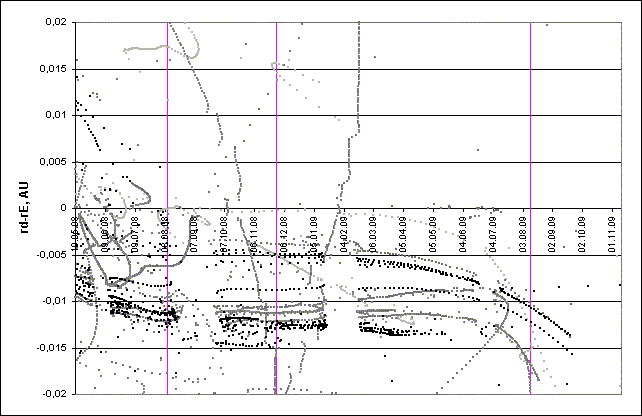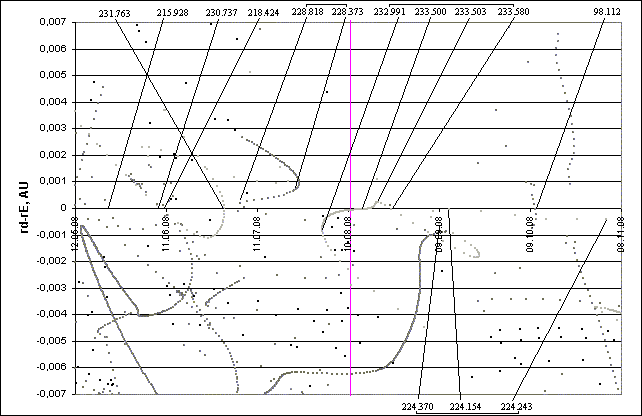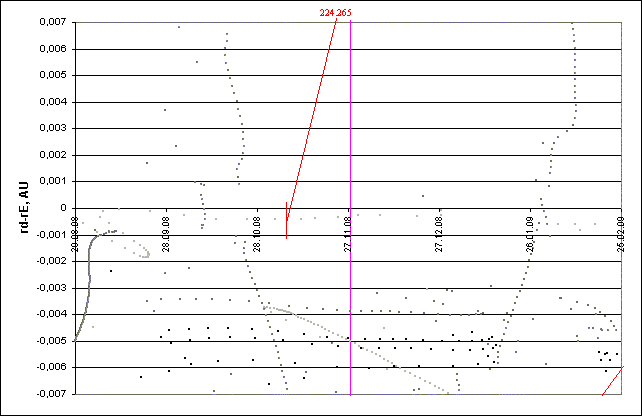72P-ids 2008: prediction of activity
to the list of predictions
Introduction
Computation characteristics
We'd like to introduce the results of simulation of the meteor stream produced by the comet 72P Denning-Fujikawa aimed to the prediction of shower activity in 2007. The simulation was made for the trails of latest 30 revolutions, i.e, from the 1727 trail. The Author used the program by S. Shanov and S. Dubrovsky "Comet's Dust 2.0" to calculate orbital elements of ejected meteor particles. To estimate expected ZHRs for different encounters the model by E. Lyytinen and T. van Flandern given in their paper [4] was used with some Author's alterations made in order to adopt the model for ejection velocity (Vej) instead of da0 (difference in a-semimajor axis) and to convert the model from the Leonid stream (for which it was originally created) to the 72P-ids. The computation considered only gravitational forces The following parts of trails were computed: the first 15 rev. trails for ejection velocities [-50;100] m/s, 16-30 rev. trails - [-30;50] m/s
Results
Introduction
Computation characteristics
We'd like to introduce the results of simulation of the meteor stream produced by the comet 72P Denning-Fujikawa aimed to the prediction of shower activity in 2007. The simulation was made for the trails of latest 30 revolutions, i.e, from the 1727 trail. The Author used the program by S. Shanov and S. Dubrovsky "Comet's Dust 2.0" to calculate orbital elements of ejected meteor particles. To estimate expected ZHRs for different encounters the model by E. Lyytinen and T. van Flandern given in their paper [4] was used with some Author's alterations made in order to adopt the model for ejection velocity (Vej) instead of da0 (difference in a-semimajor axis) and to convert the model from the Leonid stream (for which it was originally created) to the 72P-ids. The computation considered only gravitational forces The following parts of trails were computed: the first 15 rev. trails for ejection velocities [-50;100] m/s, 16-30 rev. trails - [-30;50] m/s
Results

Fig. 1. Space-temporal projection of 72P-ids trails parts onto their minimal distance passages dirung the period 10.05.2008-10.11.2009 (correspondence between colours of the particles and their ejection velocities can be seen here).

Fig. 2. Detailed space-temporal projection of 72P-ids trails parts onto their minimal distance passages dirung the period 12.05.2008-08.11.2008 (correspondence between colours of the particles and their ejection velocities can be seen here).

Fig. 3. Detailed space-temporal projection of 72P-ids trails parts onto their minimal distance passages dirung the period 28.08.2008-25.02.2009 (correspondence between colours of the particles and their ejection velocities can be seen here).

Fig. 4. Detailed space-temporal projection of 72P-ids trails parts onto their minimal distance passages dirung the period 12.05.2009-08.11.2009 (correspondence between colours of the particles and their ejection velocities can be seen here).
As shown on the Fig.3, in November 2008 the Earth will encounter a very thin 1908 trail. Parameters of the encounter are given below:
| trail | rD-rE | Vej | fM(fMD) | SL | MT |
| - | AU | m/s | - | ° | UT |
| 1908 | -0.00042 | -35.31 | 0.020 | 224.265 | 06.11.2008 10:32 |
Because of very low density of the trails and high negative values of ejection velocity, we do expect detectable activity from this encouter. However, any observers wishing to check the shower could look at the radiant RA=259.9°, Dec=-41.5°.
Conclusions
Excluding very non-perspective encounter with 1908 trail on 6 November 2008, we do not expect 72P-ids activity during the considered period.
References
1. "Comet's dust 2.0" program by S. Shanov and S. Dubrovsky. [Used for orbital computations.]
2. Information from Gary W. Kronk's page http://www.maa.agleia.de
3. IMO Meteor Shower Calendar 2006 http://www.imo.net/calendar/russian/2006/spring.
4. Lyytinen E, van Flandern T. "Predicting the strength of Leonid outbursts", 2000, Icarus, P. 158-160.